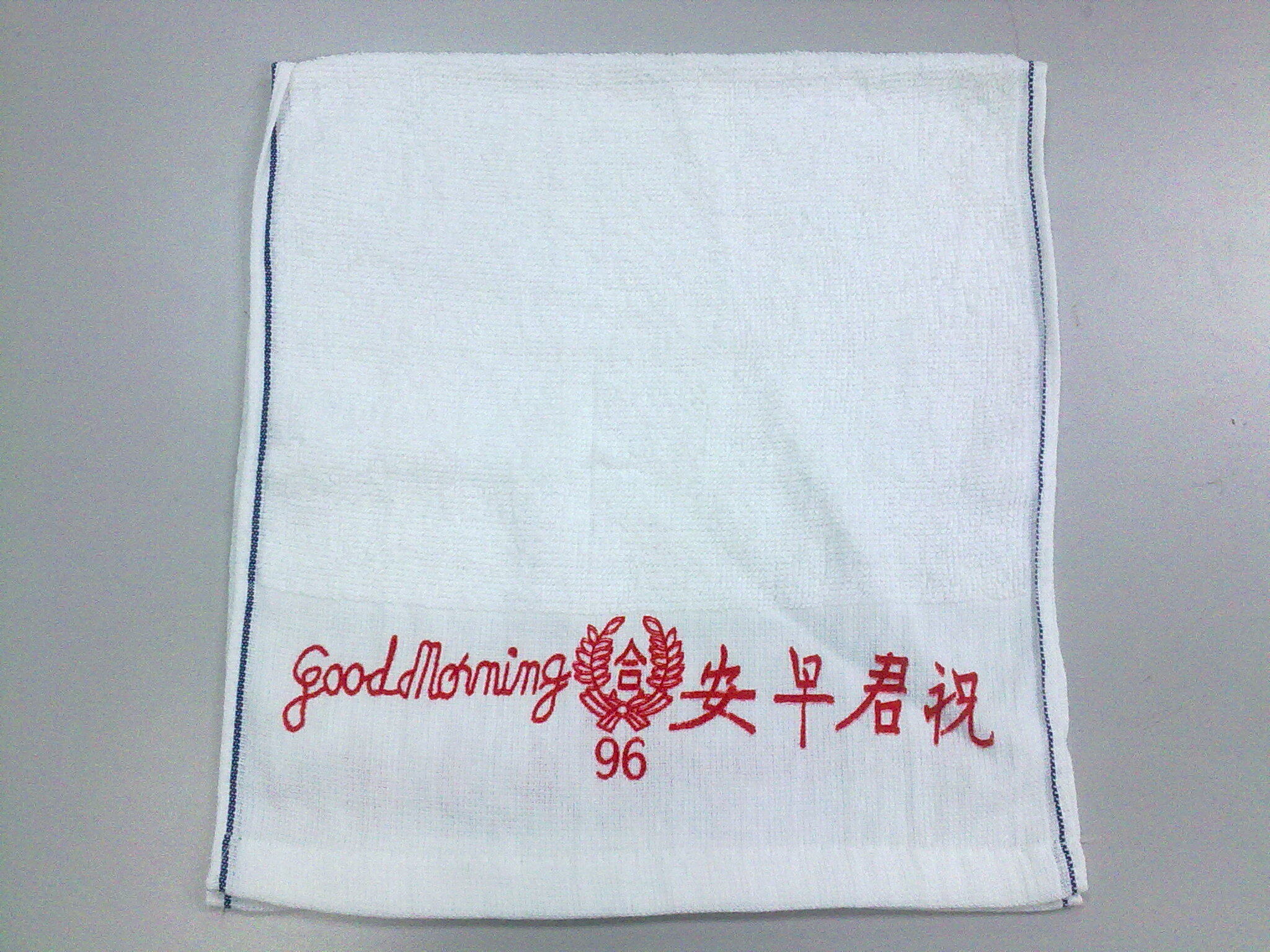In a tiled kitchen somewhere in Singapore, a red-and-white towel hangs on a hook, slightly faded from years of sun and soap. It’s embroidered with the words “Good Morning” in cheery block letters, framed by Chinese characters and a floral border. You might see the same towel tucked into the belt loop of a construction worker in Kuala Lumpur. Or draped over the handlebars of a trishaw in Penang. Or folded next to a lunch tiffin in a Taiwanese back-alley eatery. For decades, this simple cotton towel has traveled with workers across Asia—not as a fashion item or heirloom, but as a quiet, daily companion.
And yet, it’s iconic.
The Good Morning towel is more than an object of hygiene. It is a design artifact woven into the muscle memory of working-class life across Southeast and East Asia. Long before Pinterest flatlays and boutique towel brands, this utilitarian square served as the sweat-catcher, the dish-dryer, the spill-wiper, the gesture of care. It has survived because it works. And in its survival, it tells a bigger story—of labor, dignity, and the quiet beauty of repetition.
Unlike brand-name homeware, the Good Morning towel was never about aesthetics for aesthetics' sake. Originally produced in China in the 1950s and later across Southeast Asia, it was an affordable cotton towel known for its absorbency and durability. The “Good Morning” greeting—always in English, oddly enough—was paired with traditional motifs and Chinese characters, forming a visual hybrid of postcolonial optimism and cultural pride.
But what truly gave it life wasn’t marketing. It was usage.
In coffee shops (kopitiams), the towel wiped down counters, cooled the necks of servers, and padded boiling-hot mugs. In hawker stalls, it wrapped chopsticks or cleaned frying pans mid-shift. In wet markets, it was the first thing vendors reached for after icing fish or stacking leafy greens. And in homes, it became synonymous with filial care—a towel your mother might hand you after a fever sponge bath, or the one your grandfather wore over his shoulder while gardening. To see it hanging in a corner or draped over a mop handle was to feel the presence of activity, of life being lived.
You could say the towel survives out of habit. But that would miss the point.
Its design is simple but systemically smart. Cotton loops that grip moisture. A size that fits in your palm or pocket. No fuss hems. A color palette that hides stains. It’s not precious. But it is dependable. And for the working class—who often don’t have the luxury to buy separate cloths for the kitchen, the bath, the baby, and the workshop—that matters.
In that way, the Good Morning towel is part of a broader system of resourceful domestic design in Asia: enamel tins that last decades, plastic stools that stack, rice cookers that steam and stew. These aren’t things that scream sustainability—but they are. Because they are used. Really used.
Design doesn’t have to be beautiful to be meaningful. But the Good Morning towel has always carried a kind of humble aesthetic. The red stitching against white cotton. The symmetry of the floral framing. The soft wear of age. Even the act of washing and reusing it becomes a ritual. Shake it out. Scrub it clean. Hang it on the line. Fold it just so.
In homes with grandparents, the towel is more than a cloth—it’s a rhythm. You see it in the way older folks keep it handy. Not because it looks good, but because they know it will be needed. A drop of tea, a sweaty forehead, a dusty window grill. The towel is a stand-in for readiness, for being prepared in the flow of daily life.
It reminds us that home care—and self-care—doesn’t have to be branded. It can be a towel that costs a dollar, used a hundred ways.
In recent years, the Good Morning towel has begun to show up in unexpected places: on fashion runways, in artist exhibitions, as prints on tote bags and T-shirts. For many, it’s nostalgic. A callback to childhood kitchens or grandmother’s washbasin. For others, it’s aestheticized heritage—an old-school object reclaimed by a younger generation eager to anchor identity in everyday icons.
Some brands have even tried to remix the towel with new colors or luxe packaging. But the original endures, sold in stacks at neighborhood hardware stores and traditional markets. Unbranded. Unassuming. Unchanged. That resilience is part of its appeal. It hasn’t tried to reinvent itself. It just stayed relevant by being useful.
In a time when design often feels performative—eco-this, minimalist-that—the Good Morning towel reminds us of a quieter power. Utility. Repeatability. Care. It doesn’t preach sustainability, but it embodies it. Not because it’s “green,” but because it’s part of a domestic system where things are used until they fade, and then used some more.
It’s also a reminder that luxury isn’t the only lens for good design. Some of the most emotionally resonant objects in our homes are the ones that cost little, but live long. The towel that dries a crying face. The one that pads a lunchbox. The one passed silently between generations—not with ceremony, but through use.
What the Good Morning towel teaches us is that meaning doesn’t have to be declared. It can be made, over time, through touch, routine, and care. In this way, it’s less about the towel and more about what it absorbs—not just water, but memory, gesture, and intention.
Design that endures often does so not because it innovates, but because it integrates. It becomes part of how we move through the world, quietly supporting our habits, rituals, and responsibilities. The towel is a symbol of that kind of design. And also, of a kind of life—practical, hardworking, quietly dignified.
So next time you see one hanging by a stove or tucked into a waistband, don’t just call it a towel. Call it what it really is. A badge of care. A workhorse. A little square of everyday reverence.















